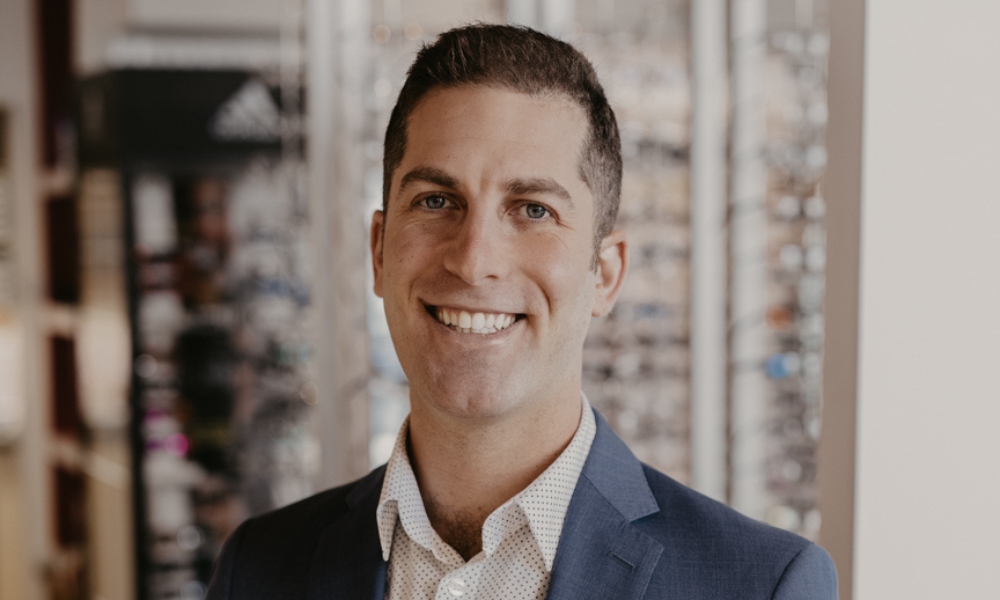'The needs of the populations have changed and it's time for vision care plans to modernize as well,' says president at the CAO

Benefits and Pensions Monitor is pleased to present a vision care special. In part 1, we previously explored the gaps in vision benefits and how eye disease is affecting workplace productivity with Medavie Blue Cross and Beneva. In today’s edition, the Canadian Association of Optometrists under 40 president Martin Spiro sheds more light on optometry, eye disease and available treatments and makes the case for why plan sponsors need to update vision care benefits that reflect current standards.
In today’s increasingly screen-centric workplaces, could outdated vision care benefits be doing more harm than good?
Dr. Martin Spiro, president of the Canadian Association of Optometrists (CAO), doesn’t mince words when explaining how modernizing vision benefits can improve quality of life for plan members.
“The current state of vision care plans is really based on an older model of eye care, which is currently not the actual reality,” he said.
What once sufficed, a basic eye exam every two years and a modest allowance for glasses, is no longer enough.
“The modern-day optometric exam is much more advanced.”
He acknowledged there’s still a long way to go, particularly around the misconception that many still think optometry is just about writing prescriptions for glasses or contact lenses. “People often think of eye exams as something you do when your vision is blurry,” he said. “But in reality, optometrists play a critical role in preventive care.”
He also disagrees with the assumption that children only need exams when they complain. “Kids don’t always know what ‘normal’ vision is, and early detection is key to their development,” he said.
Indeed, early detection is really key as today’s comprehensive eye exams often detect systemic diseases like diabetes, high blood pressure, and even early signs of neurodegenerative conditions, issues often visible in the back of the eye.
“When you go for a comprehensive eye exam, a lot is being uncovered, not only the visual system, but we're also looking at the health of the eyes, to determine both the ocular health, but also the overall systemic health,” he said.
The level of insight comes from advanced tools like wide-field retinal imaging and OCT scans, technologies that remain uncovered by many plans.
Spiro asserts that outdated plans are limiting early detection, and the consequences extend far beyond blurred vision.
“As we get a little bit older, the incidence of eyes diseases tends to go up as well,” said Spiro, pointing to some of the main diseases like glaucoma, macular degeneration and diabetic retinopathy. He asserted these diseases can develop asymptomatically until it’s too late.
“All of these diseases can cause irreversible vision loss and visual impairment. The good news is that with early detection and early management, much of this loss could be prevented,” added Spiro. “But once that nerve is damaged, you can’t go back. When we look at the back of the eyes, we make sure that our patients have good quality vision and healthy eyes for life.”
Particularly in today’s digital environment, the modern professional often works with multiple digital devices, from smartphones and laptops to external monitors, which places considerable strain on the eyes.
“We’re seeing an increase in incidence of dry eye disease, which does have an impact on productivity, not only just kind of quality of life, but also the ability to be productive and concentrate on work,” explained Spiro. “The standard professional is probably using four or five different screens now.”
Spiro underscored that while artificial tears are helpful for occasional dryness, chronic dry eye is often “multi-modal… it’s there because of a whole host of things.”
Optometrists today are equipped with new technologies that go beyond temporary relief to treat the root cause. However, procedures like LipiFlow, which treat the root cause of the disease, can run into thousands and are often excluded from benefit plans.
These may include therapies to “stimulate the glands which produce those lipids or “prescribing anti-inflammatory eye drops that reduce the inflammation,” noted Spiro. Such advancements are enabling more targeted and effective treatment for long-term relief.
“These new technologies are great because they really get to that root cause,” he said. But the lack in coverage for these technologies ultimately leaves plan members to pay out of pocket or skip care altogether.
“One exam every two years is not adequate enough to follow the disease and manage it,” he said. “The current benefits don’t really reflect the needs of these patients to make sure that their eyes stay healthy for their life.”
He noted that some tailoring of benefits might make more sense rather than blanket increases. “I think it could be targeted benefits,” he explains, referencing the idea of adjusting allowances based on specific prescriptions or treatments. That could help contain premiums while addressing real patient needs.
Looking ahead, Spiro sees vision care becoming more integrated with broader healthcare reforms.
“We’re already collaborating more and more with other practitioners,” he noted.
He described cases where optometrists detect signs of a possible stroke, leading to emergency referrals, or working closely with endocrinologists for diabetic patients.
Spiro offers a challenge for plan sponsors.
“It’s time to modernize, it’s time for eye care to get into the 21st century,” he asserted.
“We’re still using plans that are from the 80s and 90s, in terms of vision care. The needs of the populations have changed and it’s time for vision care plans to modernize as well.”



